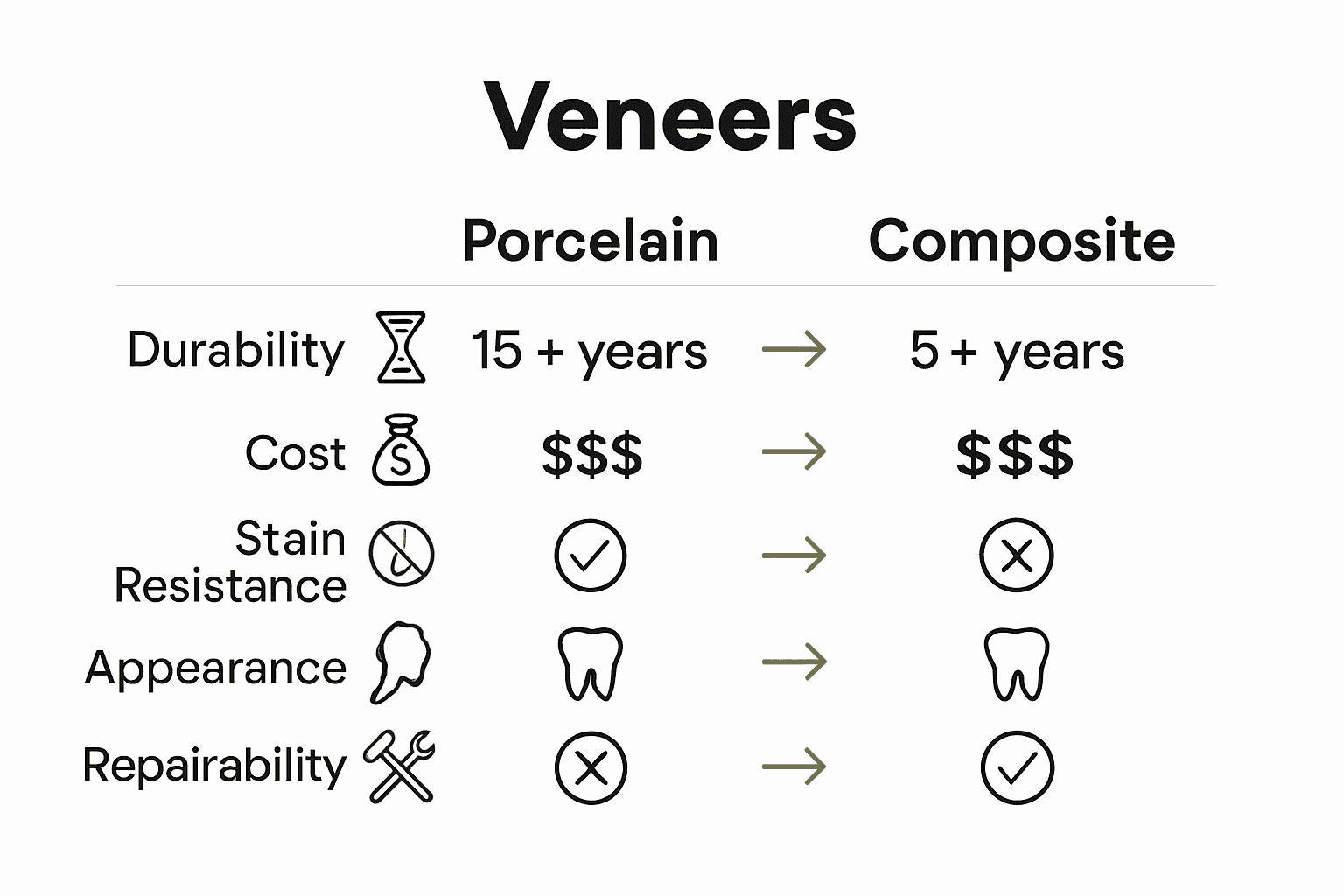
Over 600,000 people seek cosmetic dental treatments each year, with dental veneers standing out as a favorite choice. Many turn to veneers to address stains, chips, and uneven teeth when regular whitening or bonding is not enough. These custom-made shells can dramatically enhance a smile and may last for a decade or more with proper care, offering a blend of confidence, durability, and natural-looking results.
Table of Contents
- What Are Dental Veneers and How They Work
- Types of Dental Veneers and Key Differences
- The Dental Veneer Procedure Step-by-Step
- Candidacy, Suitability, and Longevity Factors
- Costs, Risks, and Comparing Alternatives
Key Takeaways
| Point | Details |
|---|---|
| Dental Veneers Overview | Custom-made cosmetic shells that improve tooth appearance by concealing imperfections like cracks and stains. |
| Types of Veneers | Porcelain veneers are durable and natural-looking, while composite veneers are more affordable and less invasive. |
| Procedure Steps | The veneer application involves examination, tooth preparation, custom design, fitting, and bonding. |
| Candidacy Factors | Ideal candidates should have healthy tooth structure and enamel, as veneers are primarily cosmetic and may not suit everyone. |
What Are Dental Veneers and How They Work
Dental veneers are custom-made cosmetic shells designed to transform the appearance of your teeth by covering their front surfaces. According to Cleveland Clinic, these thin coverings can conceal various dental imperfections like cracks, chips, stains, and discolorations, making them a popular solution in cosmetic dentistry.
At their core, veneers function like a precision-crafted facade for your teeth. Dental Health explains that they work similarly to false fingernails, fitting precisely over the tooth’s surface. Dentists typically create these shells from two primary materials: porcelain and composite resin, each offering unique benefits for patients seeking aesthetic improvements.
The veneer application process involves several key steps:
- Detailed dental examination and consultation
- Tooth surface preparation and minor reshaping
- Custom veneer design and fabrication
- Precise bonding of the veneer to the tooth surface
Porcelain veneers are particularly prized for their durability and natural-looking appearance. They resist stains better than natural tooth enamel and can dramatically enhance your smile’s aesthetics. Porcelain Veneers in Edmonton offer patients a transformative cosmetic solution that combines both functional and visual improvements to their dental profile.
Types of Dental Veneers and Key Differences
Dental veneers come in two primary varieties, each with distinct characteristics and applications. Mouth Healthy highlights that porcelain and composite veneers represent the two main options for patients seeking cosmetic dental improvements, with significant differences in their composition, cost, and treatment approach.
Porcelain veneers are renowned for their superior durability and natural appearance. These custom-crafted shells are typically more expensive but offer remarkable long-term aesthetic benefits. They require minimal tooth preparation and provide exceptional stain resistance. In contrast, composite veneers offer a more budget-friendly and minimally invasive alternative. Cosmetic Association explains that these tooth-colored shells are directly bonded to the tooth’s surface, making them a more conservative treatment option.
Key differences between porcelain and composite veneers include:
Here’s a comparison of porcelain and composite dental veneers:
| Feature | Porcelain Veneers | Composite Veneers |
|---|---|---|
| Longevity | 10-15 years | 5-7 years |
| Cost | Higher | More affordable |
| Stain Resistance | Excellent | Moderate |
| Appearance | Highly natural-looking | Good, less translucent |
| Tooth Preparation | Moderate removal | Minimal removal |
| Application Time | Multiple visits | Single visit possible |
| Repair/Replacement | Difficult, entire veneer | Easier, spot repairs |
- Longevity: Porcelain veneers last 10-15 years, while composite veneers typically last 5-7 years
- Cost: Composite veneers are significantly less expensive
- Preparation: Porcelain veneers require more tooth enamel removal
- Application Time: Composite veneers can often be completed in a single dental visit

Ultimately, the choice between porcelain and composite veneers depends on individual patient needs, budget, and specific dental conditions. Consulting with a professional Porcelain Veneers in Edmonton specialist can help determine the most suitable option for achieving your ideal smile transformation.
The Dental Veneer Procedure Step-by-Step
The dental veneer procedure is a meticulously planned process that transforms your smile through several precise stages. Dental Health outlines the fundamental steps, which begin with a comprehensive dental examination to assess your oral health and determine the most appropriate veneer approach.
Initial tooth preparation is crucial and requires careful consideration. According to GoToAPro, the process involves removing a minimal amount of tooth structure, typically limited to the enamel. This delicate preparation ensures that the veneer will fit seamlessly and look natural, without creating a bulky or oversized appearance.
The complete veneer procedure typically follows these detailed steps:
- Initial consultation and smile assessment
- Tooth surface preparation and minimal enamel removal
- Digital or physical impression taking
- Veneer design and custom fabrication
- Precise veneer fitting and bonding
- Final adjustments and polishing

After the veneers are created, the bonding process is equally critical. Dental professionals use specialized adhesive techniques to ensure a strong, long-lasting attachment. For patients interested in exploring comprehensive cosmetic dentistry treatments, this meticulous procedure represents just one of many innovative solutions to enhance dental aesthetics and confidence.
Candidacy, Suitability, and Longevity Factors
Dental veneers are not a universal solution for everyone. SDM emphasizes that veneers are exclusively cosmetic treatments designed to modify tooth appearance in size, shape, color, and length. Not all patients are ideal candidates for this procedure, with key considerations including overall dental health, existing tooth structure, and specific aesthetic goals.
Cleveland Clinic reveals that with proper care, dental veneers can last an impressive 10 to 15 years. Their exceptional durability stems from superior stain resistance compared to natural tooth enamel, making them an attractive long-term investment for patients seeking aesthetic dental improvements.
Key factors determining veneer candidacy include:
- Presence of healthy, strong tooth structure
- Minimal existing dental decay
- Sufficient tooth enamel
- Commitment to excellent oral hygiene
- Realistic aesthetic expectations
Patients with certain dental conditions may require alternative treatments. Individuals experiencing active gum disease, severe tooth decay, or those with insufficient enamel might need preliminary dental work before considering veneers. For personalized guidance, consulting a cosmetic dentistry professional can help determine the most appropriate dental aesthetic solution for your unique needs.
Costs, Risks, and Comparing Alternatives
Dental veneers represent a significant financial investment in your smile’s aesthetic transformation. Dentaly provides insight into the cost spectrum, highlighting that prices can range dramatically from 300 to 3,000 per tooth. These variations depend on multiple factors including material selection, number of veneers required, and the specific dental practice’s location and expertise.
When considering alternative treatments, patients have several options to explore. Dental Health explains that traditional alternatives include natural-colored filling materials for minor repairs and dental crowns for teeth requiring substantial structural reinforcement. Veneers occupy a unique middle ground – less invasive than crowns but more comprehensive than simple fillings.
Key cost and treatment comparison points include:
- Composite Veneers: More affordable, single-visit procedure
- Porcelain Veneers: Higher initial cost, longer-lasting results
- Dental Fillings: Least expensive, limited cosmetic improvement
- Dental Crowns: Most invasive, complete tooth coverage
Potential risks associated with veneers include tooth sensitivity, potential color mismatch, and the irreversible nature of the procedure. While these treatments offer remarkable aesthetic benefits, patients should carefully weigh their options and explore comprehensive cosmetic dentistry treatments to make an informed decision tailored to their specific dental needs and budget constraints.
Transform Your Smile with Expert Dental Veneers at Unity Square Dental
If you are looking to hide cracks, chips, or discoloration and want a naturally beautiful smile that lasts, dental veneers might be the right solution for you. This article highlighted important details such as the choice between porcelain and composite veneers, the step-by-step procedure, and the lasting benefits that can reshape your confidence. You deserve personalized care that addresses your unique dental structure, budget, and aesthetic goals.

Discover how our Edmonton-based clinic combines advanced technology and expert cosmetic dentistry treatments to deliver stunning results tailored just for you. Don’t wait to boost your smile and self-esteem. Visit Unity Square Dental to schedule your consultation and learn more about Porcelain Veneers in Edmonton. Take the first step now and experience the lasting benefits of a smile makeover crafted with precision and care.
Frequently Asked Questions
What are dental veneers and how do they work?
Dental veneers are custom-made cosmetic shells that cover the front surfaces of teeth to conceal imperfections like cracks, chips, and stains. They function similarly to false fingernails and are typically made from porcelain or composite resin.
What are the different types of dental veneers?
The two main types of dental veneers are porcelain and composite veneers. Porcelain veneers are known for their durability and natural appearance, while composite veneers are more affordable and involve minimal tooth preparation.
How long do dental veneers last?
With proper care, dental veneers can last between 10 to 15 years, especially porcelain veneers, which are more stain-resistant and durable than composite options that typically last 5 to 7 years.
What are the costs associated with dental veneers?
The cost of dental veneers can range from 300 to 3,000 per tooth. Factors influencing the price include the type of material used, the number of veneers needed, and the dental practice’s location and expertise.

